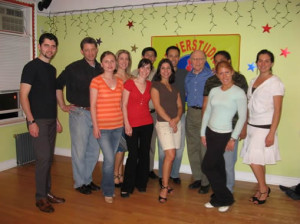You just started taking Argentine tango classes and want to practice, but you’re having trouble finding the right music to practice to. Piazolla and Puligese are great, but difficult to dance to for a beginner, and even for experienced dancers. There are hundreds of amazing tango songs to choose from, but when starting out with tango lessons, what you want is songs with a steady and clear tempo, and not performance type pieces. You want songs that you won’t have trouble finding the beat. Here is a list of great tango songs for the beginner tango dancer. At our two Brooklyn dance schools, we find that these are the best songs for the beginner Argentine tango dancer. They all have a very clear beat, and are also great pieces of music.

Tango studio in Brooklyn NY.
Argentine Tango Songs For Beginners: Don Juan/Carlos Di Sarli, El Once/Carlos Di Sarli, A la Gran Muneca/Di Sarli, La Cumparsita/Di Sarli, Milonguro Viejo/Di Sarli, Yo Tambien Era Dichoso/Francisco Canero, Pura Parada/Canero, El Pescante/Canero, DonJuan/Canero, Por Tener un Corazon/Rodlofo Biagi, 16 y Vovemos A Queremos/Rodolfo Biagi, Sentimiento Gauch/Francisco Lomoto, Yo Tambien Sone/Romero, Ojos Negros Que Fascinan/Ray Salina, Yo No Se Porque Razon/Enrique Rodriquez, Cafe Dominguez/Angel D’gastino
